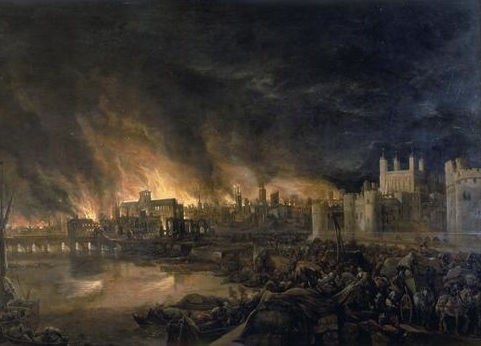*Image Credit: Wikimedia Commons At a small bakery on Pudding Lane, one of the worst fires in human history broke out in London on September 2, 1666. More than 13,000 homes burned to the ground as the conflagration consumed much of the central districts of the city, feeding on the largely wood construction to advance much quicker than the primitive firefighting forces of the day could keep up. As many as 80,000 people were left homeless when the Great Fire burned out on September 5th. The medieval district of London, and the city as a whole, had faced numerous damaging fires over the centuries. With narrow streets and buildings constructed in close proximity, officials had taken the precaution of banning construction using wood and grasses for centuries — but some residents, coming to London in search of opportunity and living in immense poverty, continued doing so. On top of that, a variety of fire-requiring professionals like glaziers and blacksmiths continued to work within city walls despite rules against it. By 1665, King Charles II, had issued two separate orders against the construction methods which made fire much more likely — particularly housing units built jutting over the street. They were largely ignored. A little after midnight on September 2, 1666, the risk of disaster came to fruition. Thomas Farriner and his family had been sleeping on the upper floor of their home when they realized fire had broken out on the floors below in Farriner’s bakery storefront. Trapped, his wife, children and he leaped next door into a neighbor’s window while others attempted to squelch the flames. Constables arrived an hour later and, noticing the size of the fire, determined the neighboring houses should be demolished in order to keep the damage from spreading. Residents disagreed, calling for Lord Mayor Sir Thomas Bloodworth to make a determination, as the law required. Bloodworth, unwilling to allow the buildings to be brought down without telling the property owners, dismissed firefighters’ calls and left in a huff as the flames proceeded toward paper factories on the waterfront. Samuel Pepys, then an administrator in the Navy Office, observed it from the Tower of London the next morning and realized high winds were fanning the flames. Without proper intervention, the whole city might be in danger — if not from fire, then from the mass of people fleeing the out-of-control blaze. Having moved north and west over the next two days, the fire reached St. Paul’s Cathedral on September 4th. Tearing through the stone landmark most thought would help slow the flames down, the conflagration began advancing west towards Westminster and the royal palaces while pushing east towards the weapons stores at the Tower of London. With firemen focusing their attention on the opposite side of the fire, soldiers in the Tower used some of the gunpowder stored there to blow up houses and create a firebreak. But for this basic decision, a large chunk of London might have been destroyed by a massive explosion. Early on the morning of September 5th, the winds died down enough that the fire could be managed. Encampments throughout the city were set up, acting as temporary homes — and rumor mills spinning stories of a French or Dutch invasion — for the tens of thousands left without a place to sleep. Eager to find someone to blame, English officials took the confession of Robert Hubert, a French craftsman making watches in the city, and swiftly hanged him. (Officials were unaware of Hubert’s mental disabilities — a later investigation determined he had not arrived in London until after the disaster had begun to unfold.) In a bid to rebuild, Charles II employed a young man named Christopher Wren — who had been working on St. Paul’s Cathedral — to build 50 new churches to replace those that had been lost. Writer John Evelyn would lay out the streets, giving the district the character it enjoys today.
September 2, 1666 CE – London Bursts into Flames
*Image Credit: Wikimedia Commons At a small bakery on Pudding Lane, one of the worst fires in human history broke out in London on September 2, 1666. More than 13,000…
451
